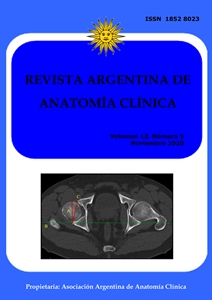ESTUDIO ANATOMO-TOMOGRÁFICO DE LA VERSIÓN ACETABULAR
DOI:
https://doi.org/10.31051/1852.8023.v12.n3.30218Palabras clave:
versión acetabular; tomografía computada; retroversión.Resumen
Introducción: El estudio imagenológico de las características morfométricas de la articulación de la cadera en una muestra de casos asintomáticos, reviste importancia para comprender variantes de normalidad.
Material y método: Estudio retrospectivo sobre un archivo de tomografías computadas solicitadas por patologías abdomino-pélvicas, de ambos sexos con edades entre 18 y 45 años, ortopédicamente sanos. Se realizó una medición digital de la versión acetabular. Las variables consideradas y analizadas con estadística descriptiva fueron edad, sexo y versión acetabular.
Resultados: Se incluyeron 165 pelvis, 102 masculinas (61,9%) y 63 femeninas (38,1%). La edad media de la cohorte fue de 36,4 años. La versión fue positiva (anteversión) en 163 casos, con una media masculina de 17,1° ± 2,7° (p <0,03) y femenina de 19,8° ± 3,9° (p <0,01). Dos pelvis masculinas tenían retroversión (1,2%). La diferencia de versión contralateral promedio fue de 1,15° ± 2,2°.
Conclusión: El acetábulo femenino tiene una anteversión promedio mayor que el masculino. Es frecuente encontrar anteversión acetabular contralateral diferente. La prevalencia de retroversión en una muestra adulta joven asintomática es baja.
Referencias
Anda S, Svenningsen S, Grontvedt T, Benum P. 1990. Pelvic inclination and spatial orientation of the acetabulum. A radiographic, computed tomographic and clinical investigation. Acta Radiol 31: 389-94.
Ganz R, Parvizi J, Beck M, Leunig M, Notzli H, Siebenrock KA. 2003. Femoroacetabular impingement: a cause for osteoarthritis of the hip. Clin Orthop Relat Res 417: 112-20.
Giori NJ, Trousdale RT. 2003. Acetabular retroversion is associated with osteoarthritis of the hip. Clin Orthop Relat Res 417: 263-69.
Jamali AA, Deuel C, Perreira A, Salgado CJ, Hunter JC, Strong EB. 2007. Linear and angular measurements of computer-generated models: are they accurate, valid, and reliable? Comput Aided Surg 12: 278-85.
Jamali AA, Mladenov K, Meyer DC, Martinez A, Beck M, Ganz R, Leunig M. 2007. Antero-posterior pelvic radiographs to assess acetabular retroversion: high validity of the “cross-over-sign” J Orthop Res 25: 758-65.
Kalberer F, Sierra RJ, Madan SS, Ganz R, Leunig M. 2008. Ischial spine projection into the pelvis: a new sign for acetabular retroversion. Clin Orthop Relat Res 466: 677-83.
Klasan A, Neri T, Sommer C, Leie MA, Dworschak P, Schofer MD, Heyse TJ. 2019. Analysis of acetabular version: Retroversion prevalence, age, side and gender correlations. J Orthop Translat 18: 7-12.
Klingenstein GG, Zbeda RM, Bedi A, Magennis E, Kelly BT. 2013. Prevalence and preoperative demographic and radiographic predictors of bilateral femoroacetabular impingement. Am J Sports Med 41: 762-68.
Larson CM, Moreau-Gaudry A, Kelly BT, Byrd JW, Tonetti J, Lavallee S. 2015. Are normal hips being labeled as pathologic? A CT-based method for defining normal acetabular coverage. Clin Orthop Relat Res 473: 1247-54.
Maruyama M, Feinberg JR, Capello WN, D’Antonio JA. 2001. The Frank Stinchfield Award: Morphologic features of the acetabulum and femur: anteversion angle and implant positioning. Clin Orthop Relat Res 393: 52-65.
Murtha PE, Hafez MA, Jaramaz B, DiGioia AM. 2008. Variations in acetabular anatomy with reference to total hip replacement. J Bone Joint Surg Br 90: 308-13.
Perreira AC, Hunter JC, Laird T, Jamali AA. 2011. Multilevel measurement of acetabular version using 3-D CT-generated models: implications for hip preservation surgery. Clin Orthop Relat Res 469: 552-61.
Rubalcava J, Gómez-García F, Ríos-Reina JL. 2012. Ángulo de anteversión acetabular de la cadera en población adulta mexicana medida por tomografía computada. Acta Ortop Mex 26: 155-61.
Sengodan VC, Sinmayanantham E, Kumar JS. 2017. Anthropometric analysis of the hip joint in South Indian population using computed tomography. Indian J Orthop 51: 155-61.
Siebenrock KA, Schoeniger R, Ganz R. 2003. Anterior femoro-acetabular impingement due to acetabular retroversion: treatment with periacetabular osteotomy. J Bone Joint Surg Am 85: 278-86.
Stem ES, O’Connor MI, Kransdorf MJ, Crook J. 2006. Computed tomography analysis of acetabular anteversion and abduction. Skeletal Radiol 35: 385-89.
Suzuki D., Nagoya S., Takashima H., Tateda K., Yamashita T. 2017. Three-dimensional orienta-tion of the acetabulum. Clin Anat 30: 753-60.
Tallroth K, Lepistö J. 2006. Computed tomo-graphy measurement of acetabular dimensions: Normal values for correction of displasia. Acta Orthop 77: 598-602
Tannenbaum E, Kopydlowski N, Smith M, Bedi A, Sekiya JK. 2014. Gender and racial differences in focal and global acetabular version. J Arthroplasty 29: 373-76.
Vandenbussche E, Saffarini M, Taillieu F, Mutschler C. 2008. The asymmetric profile of the acetabulum. Clin Orthop Relat Res 466: 417-23.
Wassilew GI, Heller MO, Janz V, Perka C, Müller M, Renner L. 2017. High prevalence of acetabular retroversion in asymptomatic adults: a 3D CT-based study. Bone Joint J 99-B: 1584-89.
Werner CM, Copeland CE, Ruckstuhl T, Stromberg J, Turen CH, Kalberer F. 2010. Radiographic markers of acetabular retro-version: correlation of the cross-over sign, ischial spine sign and posterior wall sign. Acta Orthop Belg 76: 166-73.
Zeng Y, Wang Y, Zhu Z, Tang T, Dai K, Qiu S. 2012. Differences in acetabular morphology related to side and sex in a Chinese population. J Anat 220: 256-62.
Zhang H, Wang Y, Ai S, Chen X, Wang L, Dai K. 2017. Three-dimensional acetabular orientation measurement in a reliable coordinate system among one hundred Chinese. PloS one, 12, e0172297.
Descargas
Publicado
Número
Sección
Licencia
Derechos de autor 2020 Carlos M. Quinteros

Esta obra está bajo una licencia internacional Creative Commons Atribución-NoComercial 4.0.
Los autores/as conservarán sus derechos de autor y garantizarán a la revista el derecho de primera publicación de su obra, el cuál estará simultáneamente sujeto a la Licencia de reconocimiento de Creative Commons que permite a terceros compartir la obra siempre que se indique su autor y su primera publicación en esta revista. Su utilización estará restringida a fines no comerciales.
Una vez aceptado el manuscrito para publicación, los autores deberán firmar la cesión de los derechos de impresión a la Asociación Argentina de Anatomía Clínica, a fin de poder editar, publicar y dar la mayor difusión al texto de la contribución.



